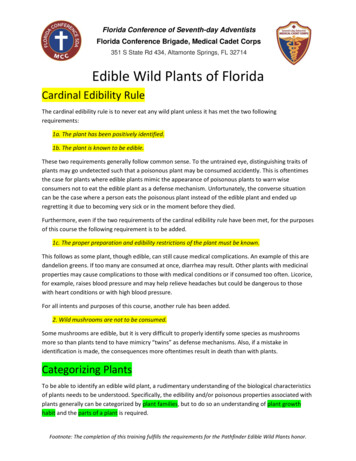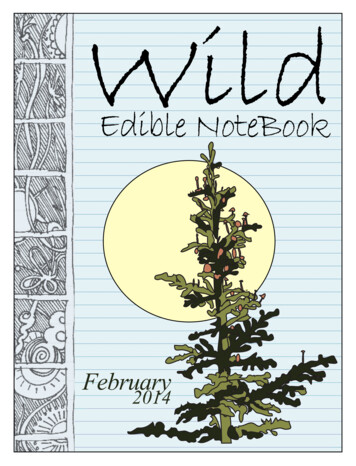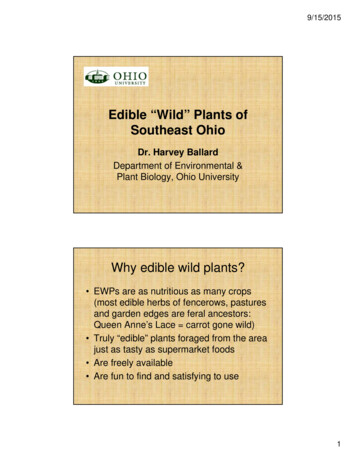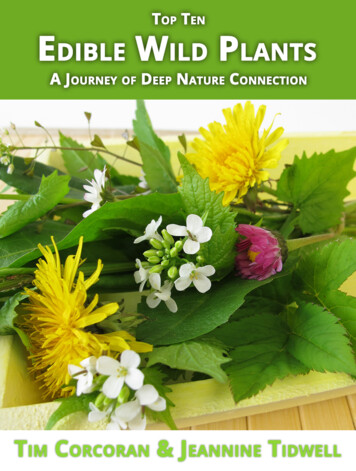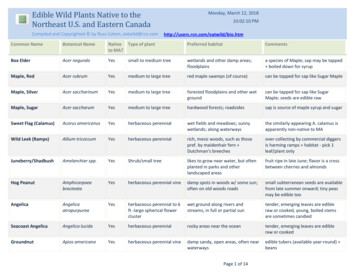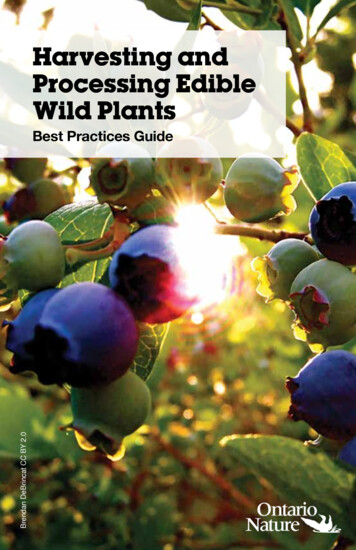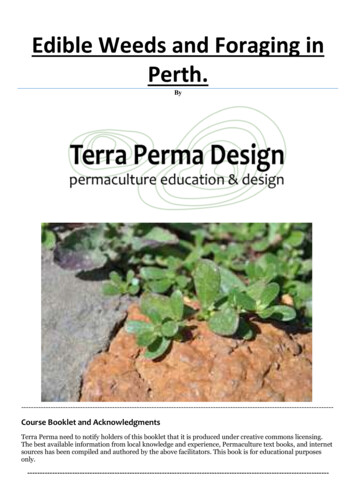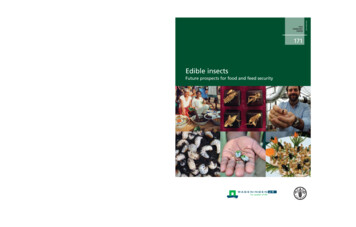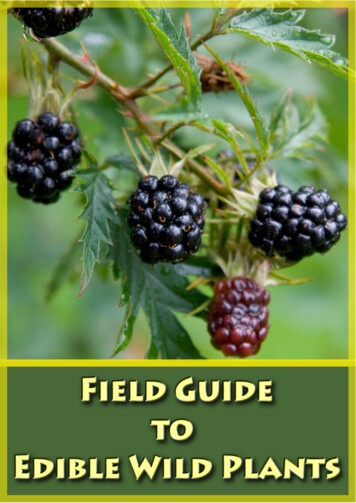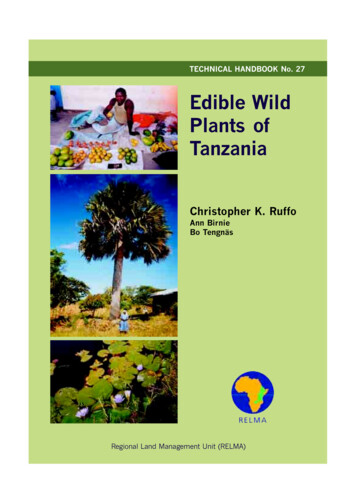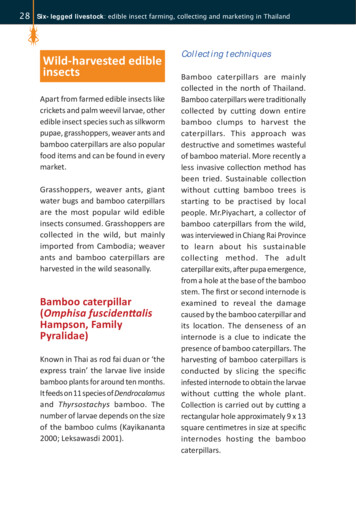
Transcription
28Six-legged livestock: edible insect farming, collecting and marketing in ThailandWild-harvested edibleinsectsApart from farmed edible insects likecrickets and palm weevil larvae, otheredible insect species such as silkwormpupae, grasshoppers, weaver ants andbamboo caterpillars are also popularfood items and can be found in everymarket.Grasshoppers, weaver ants, giantwater bugs and bamboo caterpillarsare the most popular wild edibleinsects consumed. Grasshoppers arecollected in the wild, but mainlyimported from Cambodia; weaverants and bamboo caterpillars areharvested in the wild seasonally.Bamboo caterpillar(Omphisa fuscidenƩalisHampson, FamilyPyralidae)Known in Thai as rod fai duan or ‘theexpress train’ the larvae live insidebamboo plants for around ten months.It feeds on 11 species of Dendrocalamusand Thyrsostachys bamboo. Thenumber of larvae depends on the sizeof the bamboo culms (Kayikananta2000; Leksawasdi 2001).Collecting techniquesBamboo caterpillars are mainlycollected in the north of Thailand.Bamboo caterpillars were tradi onallycollected by cutting down entirebamboo clumps to harvest thecaterpillars. This approach wasdestruc ve and some mes wastefulof bamboo material. More recently aless invasive collec on method hasbeen tried. Sustainable collec onwithout cutting bamboo trees isstarting to be practised by localpeople. Mr.Piyachart, a collector ofbamboo caterpillars from the wild,was interviewed in Chiang Rai Provinceto learn about his sustainablecollecting method. The adultcaterpillar exits, a er pupa emergence,from a hole at the base of the bamboostem. The first or second internode isexamined to reveal the damagecaused by the bamboo caterpillar andits loca on. The denseness of aninternode is a clue to indicate thepresence of bamboo caterpillars. Theharves ng of bamboo caterpillars isconducted by slicing the specificinfested internode to obtain the larvaewithout cu ng the whole plant.Collec on is carried out by cu ng arectangular hole approximately 9 x 13square cen metres in size at specificinternodes hosting the bamboocaterpillars.
Six-legged livestock: edible insect farming, collecting and marketing in ThailandThe female moth lays a mass of 80 to130 eggs on the sheaths at the baseof bamboo shoots. A er hatching, theyoung larvae bore an entrance holemostly from the fi h to the tenthinternodes. The larvae live and eatinside the bamboo shoot, usually ayoung shoot, on the upper part, un lthey are 45 to 60 days old, when theymove down to congregate in theinternode with the exis ng egresspoint for another eight months. TheRoyal Forest Department recommendsthat the best time for collectingbamboo caterpillars is around Januaryto April when bamboo caterpillars canbe obtained from the specificinternode and the infested bambooculm can be harvested for lateru liza on (Kayikananta 2000).Generally, the infested bamboo culmsare stronger than the non-infestedones because the wood cells are smalland dense, making them stronger andheavier than normal bamboo. Theycan be u lized to make bamboohandicra s and construc on poles.Rearing techniqueThe best prac ce for farming bamboocaterpillars has yet to be developed.Currently, the Royal Forest Departmenthad developed management rearingtechniques for bamboo caterpillars(Kayikananta 2000). Two managementmethods are recommended. The firstis controlling ma ng in a nylon netcage covering the bamboo shoot andthe second is releasing moths fornatural ma ng into the bamboo plot.The la er is best because it is easyand convenient.Economics and marketingAccording to farmer groups at TambonWaree, Chiang Rai Province, each yearabout 500 kilograms of bamboocaterpillars are harvested and sold atTHB200-250/kilogram to buyers whocome to their villages.Mr Jaturong, an edible insectentrepreneur, is one of the biggestbuyers of bamboo caterpillars. Hiscompany brand is ‘Mae Urai, EdibleInsect’. Each year he buys at least20 000 kilograms of bamboo caterpillarsfrom villages in the north of Thailand;10-20 percent comes fromneighbouring countries such as LaoPDR and Myanmar. The product ispackaged in both uncooked frozenpacks and ready-to-eat boxes (deepfried beforehand). The uncookedfrozen packs are distributedthroughout Thailand via the Makrowholesale supermarket chain. Onaverage, 1 000 kilograms are sold eachmonth at THB365/kilogram. Theready-to-eat (cooked) bamboocaterpillars are packed in plas c boxescontaining 100 grams and sell atTHB130 in retail shops. Each month29
30Six-legged livestock: edible insect farming, collecting and marketing in Thailandaround 3 500 to 4 000 boxes are sold.Recently, the company has developeda new product line of cooked bamboocaterpillars sealed in a container thatcan be heated in a microwave ovenbefore ea ng.Opportunities and constraintsBamboo caterpillars are one of themost popular edible insects and theselling price is s ll quite high comparedto other edible species. A rearingtechnique has been developed,although it is s ll based on seminatural habitat and s ll needs bambooas the food source. However, withproper management of semi-naturalfarming and harvesting, bamboocaterpillars can become a morepopular edible insect and help withincome genera on for local people.The area of bamboo planta ons couldbe increased for farming purposes –an indirect contribution toenvironmental conserva on.Lack of knowledge or only basicunderstanding about the biology,ecology and habitat of thesecaterpillars by local harvesterspresents a risk to the ongoingavailability of the species. Therefore,proper management and harves ngtechniques for sustainable use of thisinsect are urgently needed for localpeople; mainly ethnic groups in thenorth of Thailand.As the bamboo caterpillar is widelyconsumed and in demand, a simpleand efficient breeding technology forbamboo caterpillars at the farm levelas well as imported product processingshould be further inves gated anddeveloped.Weaver ant (Oecophyllasmaragdina Fabricius,Family Formicidae)Weaver ants are known locally as ‘red’ants or mod-daeng and are a populardelicacy. The ant workers constructnests by weaving together leavesusing larval silk. Many ant coloniescan be found on one tree.Weaver ants are predominantly foundin the northeast and have beeninterlinked with the way of life ofpeople in this region for a long me.Tradi onal local folk songs and danceshave included stories of red ant eggharves ng. Red ant eggs (the larvaland pupal stage), or khai mod-daengare popular food. Pupae and adultsare also eaten. The most populardishes, par cularly in the northeast,are omelet mixed with red ant eggsand Thai red ant egg salad (yum khaimod-daeng).Usually weaver ants are harvestedfrom trees in the wild. However, some
Six-legged livestock: edible insect farming, collecting and marketing in Thailandfarmers can breed and maintainweaver ant colonies in their owngardens on mango trees. The coloniescan be maintained and expanded iftheir host trees are protected frompredators and have good access towater. The weaver ants need waterto produce ace c acid.A method to propagate ant nests inmango orchards is the use of overheadant highways that link the trees of theorchard. These ant highways help theants to conserve energy by notneeding to leave their trees and alsoprotect them from ground basedpredators. Consequently nestmul plica on is accelerated. Thehighways are made from any type ofrope, except plas c material, butra an canes are preferred.Collecting techniquesIn north and northeast Thailand theseason for weaver ants’ harves ngusually occurs once a year during thedry season between February andMay. During this period the arborealnests of the weaver ants are full ofeggs, larvae and pupae. In PetchabunProvince the season occurs fromJanuary to May and three crops areobtained annually.Harves ng is undertaken using a longbamboo pole with a bag or basketa ached with strings to the p. A holeis poked into the nest with the p ofthe pole and it is shaken so the larvaeand pupae fall down into the bag.Then the bag is poured onto a plateor container and some rice or tapiocaflour is added to prevent the ants fromclimbing up to bite the collector. Abranch is put on the plate for adultants to climb back up the branch andit is whipped against a tree to releasethe adult ants. The remaining larvaeand pupae are removed forconsump on (Lewvanich et al. 1999).Economics and marketingInformation on production andmarke ng of weaver ants is limited toindividual cases. Currently, the marketprice for weaver ant eggs is roundTHB250-500/kilogram depending onthe period and loca on. When theseason is nearly over, the price will behigh. Usually 1-2 kilograms of weaverants can be collected in the wild eachday although some collectors cancollect 5-8 kilograms/day. About300-400 grams of larvae and pupaeper nest can be harvested. On averageone collector can earn THB250-500/day.The income for weaver ant sellers atmarkets in the northeast and north(based on interviews) is around THB1 200-3 000/day with around 5-10kilograms of weaver ants sold per day(on average 5 kilograms/day).31
32Six-legged livestock: edible insect farming, collecting and marketing in ThailandOpportunities and constraintsOne wholesaler at Talad Thai marketin Bangkok, which is one of the biggestedible insect markets, can sell around30-40 kilograms/day and net profit isaround THB2 000-2 500/day.Weaver ants can generate goodincome for both collectors and sellersbut weaver ant harves ng is s ll asideline occupa on. Income fromtheir collec on exceeds normal farmincome from rice or cassava produc onfor example. However, there is only ashort harves ng period of three tofour months per year star ng inFebruary. Weaver ants are sold asfresh produce in markets everywhere,par cularly in the north and northeastduring the harves ng period in thedry season. Canned weaver ants inbrine are also sold, a common prac cewhich preserves the product for a longme, ideal for export to overseasmarkets.Weaver ants are very popular andconsumer demand is higher than thenatural supply. According to localpeople, numbers of weaver ants havebeen decreasing and they are moredifficult to find in the wild. Decreasingpopula ons are a nega ve impact onecological systems because ants arepredators and perform manyecological roles that are beneficial tohumans, including the suppression ofpest popula ons. Weaver ants werefirst used for biological control ofcitrus pests in China, and are used inmango and cashew planta ons inAustralia (Peng et al. 1999; Peng andChris an 2004-2007).Weaver ants can easily be semifarmed in home gardens by feedingwith food scraps and sufficient water;colonies can be expanded with propermanagement. However, biological andecological aspects, par cularly findingthe queen of the colony or crea ng anew queen for the colony as well aspreferred trees and ecological habitatneed proper understanding. Weaverant queens do not live in the largenests seen lower down in the treehost. The queen is found in a smallnest at the highest point of the treewhere it is difficult to reach. A colonyon a tree without a queen willeventually die.
Six-legged livestock: edible insect farming, collecting and marketing in ThailandGiant water bug(Lethocerus indicusLep.-Serv., FamilyBelostomaƟdae)The giant water bug is na ve toSoutheast Asia. It is a popular edibleinsect, known by locals as malaengda na and is consumed in almost allparts of Thailand. The whole bugexcept the wings is eaten. It can begrilled or fried or used as an extractin sauces to make Nam Phrik Mangda,a type of chili sauce. Usually the maleis preferred as the male has a scentgland that can produce a strongdis nc ve smell.Collecting techniquesGiant water bugs live in s ll water,swamps and rice paddies. During therainy season (May to August) theycome out of the water and area racted to lights, especially blueneon lights. One common methodfor catching them in a field is to setup a blue neon light with a longbamboo pole 2-3 metres high. A watercontainer is placed on the ground tocollect the bugs that fall down. Fishingnets are also used to harvest themfrom swamps and ponds (Lewvanichet al. 1999).Economics and marketingGiant water bugs are predaceousinsects and usually sensitive topolluted environments. Although thegiant water bug is a very popularedible insect among Thai people,these days the popula on of thisspecies is declining due toenvironmental and habitat changesand pollu on. Large numbers of giantwater bugs are bought fromneighbouring countries like Cambodiaand Myanmar.Due to high demand in the market,the price is high and increasing yearby year. In the last few years one malewould cost THB10. However the pricerose to THB15 in 2011. Females arecheaper and sold at THB8-10 each.Recently giant water bugs have beensold in frozen 10-bug packages inwholesale chain supermarketsthroughout the country (for exampleMakro supermarket). Male bugs costTHB130/pack while females costTHB65/pack.One wholesaler of giant water bugsat the Kalasin edible insect market inthe northeast indicated that each dayat least 3 000 bugs are sold at THB1013/bug, mainly males. The bugs arebought from Cambodia through theedible insect market near theCambodian border.33
34Six-legged livestock: edible insect farming, collecting and marketing in ThailandOpportunities and constraintsFarming is quite difficult and laboriousbecause this species is predaceousand cannibalis c when popula onsare crowded.Recently a researcher at RajamangalaUniversity of Technology Isan in SakonNakhon Province (Sanewong NaAyudtaya 2011) has developed abreeding method to farm the giantwater bug. If this technology can bedeveloped for farming on a commercialscale, this will help to reduce themassive harves ng of giant water bugsfrom the wild which impactsecosystems by lowering predatorypopula ons.Grasshoppers (OrderOrthoptera)Many species of Orthoptera orgrasshoppers are edible. In Thailand,they include Patanga succincta,Locusta migratoria, Acrida sp.,Cyrtacanthacris tatarica and Oxyajaponica japonica (Thunb.)(Hanboonsong et al. 2001; Ra anapan2000). All of them are pests ofeconomic crops such as maize andrice. Grasshopper species, par cularlyPatanga succincta and Locustamigratoria, used to be one of themajor pests of maize and rice. Todaythey have become one of the mostpopular edible insects since they wereintroduced for human consump onby entomologists a campaign to eatgrasshoppers had been launchedbecause control efforts had beenunsuccessful. For example, in 1983this was launched by local officials andvillagers in Prachin Buri Provincecollected more than 10 tonnes for useas food (Lewvanich et al. 1999).Collecting methodGrasshoppers are collected in paddyor maize fields by using a net, a pieceof cloth or by hand at night or in theearly morning as low temperaturesmake them inactive. Beforeconsump on, the intes nes and wingsare removed and the torso is washedin water. Deep-frying is a popular wayto cook them.Economics and marketingWild collec on of grasshoppers israrely witnessed in Thailand. Mostedible grasshoppers sold in Thaimarkets come from Cambodia.Approximately 170 tonnes ofgrasshoppers are imported annuallyfor retail at Rong Kluea market at theCambodia border in Sa Kaeo Province(Ratanachan 2009). Importedgrasshoppers are sold through anetwork of fresh markets throughoutthe country by traders andintermediaries. They are purchasedby street food vendors for sale in night
Six-legged livestock: edible insect farming, collecting and marketing in Thailandmarkets and food stalls all overThailand.Grasshoppers are also sold in frozenpackages at all 51 Makro wholesalesupermarkets throughout Thailand.Each day at least 10 kilograms ofgrasshoppers are sold at each branchfor THB354/kilogram (for Bombaylocust).Opportunities and constraintsGrasshoppers are one of the mostpopular edible insects eaten by Thaipeople. Entomologists at Khon KaenUniversity have successfully developeda breeding technique to mass rearthem, but the technology s ll cannotbe expanded on a commercial scaleas it is not an economically viable wayto farm this type of insect. It hasalmost a year-long life cycle and s llrequires its natural food for feeding.Nowadays many new species ofgrasshoppers are collected from thewild. Many of them are s ll unknownand have not yet been iden fied orrecorded. The diversity of grasshopperspecies caught for consump on iswider than in the past.35
36Six-legged livestock: edible insect farming, collecting and marketing in Thailanda.b.c.d.Figure 11. Wild-harvested edible insect species: (a-b) bamboo caterpillars, (c) waspsand (d) water scavenger beetles
Six-legged livestock: edible insect farming, collecting and marketing in Thailanda.b.c.d.e.Figure 12. Wild-harvested edible insect species: (a-c) weaver ants, (d) grasshoppersand (e) dung beetles37
38Six-legged livestock: edible insect farming, collecting and marketing in ThailandBusiness and marketchannelsIt has been difficult to determine theextent of wild harves ng and farmingin Thailand because this is conductedat two levels: subsistence (use ofinsects for domes c consump on oras an addi onal source of income,mainly harves ng wild species) andcommercial producers. There is nooverriding group that oversees theindustry, so obtaining data at any level(provincial or na onal) is difficult. Thesitua on is complicated in the case ofwild-harvested insects because manyare imported from adjacent countries.Subsistence and commercialuseIt is difficult to get reliable informa onabout the extent of insects gatheredas subsistence food by individualfarmers or sold for income genera on.Good data are available for somecommercial enterprises. Theproduc on and marke ng channels,cost and income can be determinedin some cases. However, it is difficultto determine how informationobtained at the local level can beextrapolated to the provincial orna onal level because the extent ofedible insect trade varies considerablyacross Thailand, and the nature of theopera ons also varies.The trading channels for edible insectsare shown in Figures 15 and 16 (wildharvested insects) and Figures 8 and10 (farmed insects). In both cases, thevillager is either the collector or afarmer who keeps insect colonies.In the case of wild-harvested insects,the collectors may use the insectsthemselves, sell them directly to thepublic or sell to an intermediary(wholesale buyer). This can occur inThailand, but is more likely to occurin adjacent countries. The wholesalebuyer will visit individual collectorsand purchase the insects or thecollectors will directly bring insects tothe wholesale buyer’s venue. Theyare then sold to a wholesale market(for example at the Rong Kluea marketon the Cambodian border).Once the insects reach the wholesalebuyer, the scenario is similar for bothwild-harvested and farmed insects.They are stored in a cool store asfrozen packages and sold todistributors, who in turn sell to theretailers (generally market stalloperators). There can be varia ons intrading channels. An intermediarymay sell stock directly to distributorsor retailers.
Six-legged livestock: edible insect farming, collecting and marketing in ThailandEdible insect marketsStorage for edible insectsBoth fresh and cooked edible insectscan be found in all types of marketsat provincial or district levels. Severalwell-known edible insect wholesalemarkets are Rong Kluea in Sa KaeoProvince (the biggest edible insectmarket near the Cambodian border),Klong Toey market (Bangkok), TaladThai (Bangkok) and Jatujak market(Bangkok) — this market sells mainlymealworms for pet feed). Talad Kasetin Kalasin Province is one of the largestwholesale markets for distribu on ofedible insects in the northeast. Mainlyfarmed crickets, silkworm pupae,giant water bugs and grasshoppersare sold there.Markets can be divided into threegroups based on income generatedfrom selling insects. Large markets areRong Kluea and Talad Thai, which havean average monthly income ofapproximately THB300 000. Mediumsize markets are Jatujak and KlongToey markets in Bangkok, with anaverage monthly income of aroundTHB200 000 to 250 000. Small insectmarkets are located in a sca ering ofsubmarkets in provinces in thenortheast such as Warin Chamrabmarket in Ubon Ratchatani near theLao border; also Kalasin and Loeiprovincial markets. Average monthlyincome ranges from THB50 000 to80 000.Most edible insects sold in marketsare wild harvested and they areavailable seasonally. Therefore, thewholesalers usually keep insects incold storage and in some cases, likegiant water bugs, are preserved withsalt for prolonged storage. There aretwo types of cold storage: (1) plas ctanks in which the products arecovered with ice cubes (temporarystorage for two to three days) and (2)long-term storage in cold storagerooms at -18 C to -20 C (productscan be kept for one to two years).Some wholesalers have their own coldrooms with up to 300-tonne capacity.However, this type of storage has bothposi ve and nega ve aspects. Propercold storage will prolong the usablelife of the insects and also is animportant food safety factor. On thenegative side, it may encourageoverharves ng of insects that are veryseasonal. For example weaver ants collectors may be tempted to collectmore than is ecologically sustainablein order to generate more income.The wholesaler can store the weaverants and sell them at mes when theyare generally not available.Imported insect productsOnly a few species can be farmed suchas house crickets, palm weevils and39
40Six-legged livestock: edible insect farming, collecting and marketing in Thailandmealworms. Recently, giant water bugfarming technology has also beendeveloped but it has not been verysuccessful. Other species such asgrasshoppers, bamboo caterpillarsand giant water bugs are s ll wildharvested and imported fromneighbouring countries to Rong Klueamarket. Grasshoppers, black scorpionsand giant water bugs are importedfrom Cambodia. Silkworm pupae areproduced in the northeast where thesilkworm industry is located. Thesupply of silkworm pupae consump onis s ll not sufficient. Approximately270 tonnes per year are importedfrom China by wholesalers at RongKluea market. It has been reportedthat about 800 tonnes of edibleinsects are annually imported fromCambodia, Myanmar, Lao PDR andChina to Rong Kluea market(Ratanachan 2009). The top fiveimported insects are silkworm pupae,ground crickets, leaf-eatinggrasshoppers, mole crickets and giantwater bugs. The economic value ofimported insects is estimated ataround THB40 million per year.Figure 13. Edible insects are sold in various markets
Six-legged livestock: edible insect farming, collecting and marketing in Thailand41
42Six-legged livestock: edible insect farming, collecting and marketing in Thailanda.b.c.d.Figure 14. Edible insect markets and businesses: (a) wholesale sellers at Rong Klueamarket, (b) frozen packages in a supermarket, (c) precooked bamboo caterpillars onsale at a souvenir food shop and (d) precooked bamboo caterpillars for microwaving
Six-legged livestock: edible insect farming, collecting and marketing in ThailandGiant water bugsCambodia, Myanmar (overseas)Kalasin and , Si Sa Ket Provinces(domestic)CricketsThroughout Northeast ThailandGrasshoppersCambodiaSilkworm pupaeLao PDR, China (overseas)Petchabun Province (domestic)Bamboo caterpillarsNorth ThailandWholesale buyerRong Kluea market(Sa Kaeo Province)Submarkets- Northern market- Northeastern market- Central market- Southern marketPredaceous divingbeetlesNakhon Ratchasima and KalasinProvinces (domestic)CustomersMole cricketsNorth Thailand, CambodiaFigure 15. Collection and distribution market chains for edible insects43
44Six-legged livestock: edible insect farming, collecting and marketing in ThailandBamboo caterpillarsBamboo caterpillarsVillagers collectfrom Doi Wawee(Chiang Rai Province)Chiang Rai ProvinceBamboo caterpillarsLao PDR, MyanmarPackaging and processing-Souvenir shopsStreet vendorsSmall shopsRestaurantsLocal marketMakro supermarketCustomersFigure 16. Bamboo caterpillar collection and distribution chain
Six-legged livestock: edible insect farming, collecting and marketing in ThailandRecommendaƟonsThe ea ng and trade of edible insectspecies in Thailand are very commonand developing rapidly. Edible insectspecies are obtained from both wildharves ng and the farming of a fewspecies. But while the sector hasdeveloped rapidly in the last 15 years,it is still informal and ad hoc instructure and prac ce. This is anindustry where commercializa on hasoutpaced academic research forspecies suitable for farming and bestfarm prac ces. Consequently, manyques ons remain unanswered on suchma ers as management, breeding,hygiene and marke ng issues.However, the edible insect industryhas much poten al for providingprotein sources in the future and forincome generation among Thaifarmers. Development and crea onof intensive insect farms on small andlarge scales could take the pressureoff wild popula ons of insects in forestareas.Wild harvesting and insectfarmingThe edible insect industry was foundedon the wild collec on of variousspecies from forest areas aroundvillages. Today several species are verypopular with consumers and somewild species are becoming increasinglyscarce. This has resulted in the needto import some species such as giantwater bugs, bamboo caterpillars andgrasshoppers. For species such asgrasshoppers, as long as the foodcrops they consume are planted, wildharvesting is unlikely to reducepopulations significantly so wildcollec on can s ll be consideredsustainable.There is concern that the loss of otherspecies from local environments couldoccur from collec on pressure, whichcould have undesirable effects vis-à-vispest species they may control.In the future if the focus of the sectormoves away from wild collec on tofarm-based industry, this will takepressure off wild popula ons. It is alsoimportant to note that insectscollected from the wild come with theassociated hazard of no quality controland risks such as insecticidecontamina on. Therefore, farmedinsect sources are preferable from afood safety perspec ve.To date, farming technology andprac ces have only been developedfor a few species such as crickets, palmweevils and mealworms so there isan urgent need to invest in researchand development on farmingtechniques for other species that areconsumed. The Thai Government45
46Six-legged livestock: edible insect farming, collecting and marketing in Thailandcurrently injects li le research fundinginto insects as a food source comparedwith other agricultural industries.work has been done on best prac cesor improved methods of wildcollec on.Knowledge gapsAnother knowledge gap concerns thescope and span of the edible insectmarket in Thailand as many produc onand consumption data are notrecorded. Why this informa on is notavailable is because the no on of‘insects as food’ is not included inna onal food data surveys conductedby various government agencies.One of the problems facing the sectoris that it has developed ahead ofacademic research. As a result farmersencounter problems for whichacademic and extension workers mayhave no solu ons.Universi es should be aware of thisemerging sector as a future careerpath for students. In the future,entomology courses will not onlyfocus on plant protec on but also oncommercial insect produc on.Further research is urgently neededin all stages of the produc on of edibleinsects and par cularly postharvestprocessing. Currently, harvestedinsects are sold with li le processing.There is poten al to develop processesfor preserva on but as yet li le workhas been done. Proteins extractedfrom edible insects are likely to be ofinterest to food technologists andpossibly the pharmaceu cal industry.Moreover, informa on about wildharves ng of insects is limited andincomplete. Consequently, for manyspecies we cannot be sure if collec onpressure is at sustainable orunsustainable levels. In addi on, li leCapital and investment issuesThe capital cost of se ng up an insectfarm is not great, but may s ll be aconstraint for some otherwisemo vated farmers. At present, it isdifficult to borrow funds at areasonable rate for se ng up anenterprise. Some finance ins tu onsare disinterested in lending as theyare unaware of the economicsinvolved. Cricket farming has beenencouraged in Thailand through theSMCE scheme under the Ministry ofAgriculture and Co-operatives.However, villages involved in thisscheme have minimal involvement inother edible insect species such aspalm weevils and the opera on of theSMCE is not truly representa ve of acooperative in terms of profitdistribu on.
Six-legged livestock: edible insect farming, collecting and marketing in ThailandIdeally, the lead should be taken bygovernment agricultural lenders, asthey can influence the developmentand loca on of insect farms based ontheir lending policy. But to date, theagriculture banks are mainly unawareof the insect-farming industry and itspoten al.To raise the profile of insect farming,ideally an external organiza on suchas FAO needs to raise the issue withregional governments and poten alleaders. Once awareness andunderstanding of the industry’spoten al as a new or alterna vesupplier of food protein are generated,funding is likely to flow into research,processing and banking agenciesassociated with the new industry.to create demand and raise interestamong potential farmers andconsumers.Although many people in Thailandconsume insect products, the marketis s ll rela vely small. There is greatpoten al to increase consump ondemand through marke ng campaignsaimed at segments of the popula onwho are currently unaware of edibleinsect products. Some processing andproduct development may be needed,but if undertaken along with cleveradver sing, both demand and pricescould rise for the producers. Instantproducts, new foods and microwavableitems will all appeal to young andmiddle class consumers.Policy-mak
edible insect species such as silkworm pupae, grasshoppers, weaver ants and bamboo caterpillars are also popular food items and can be found in every market. Grasshoppers, weaver ants, giant water bugs and bamboo caterpillars are the most popular wild edible insects consumed. Grasshoppe
